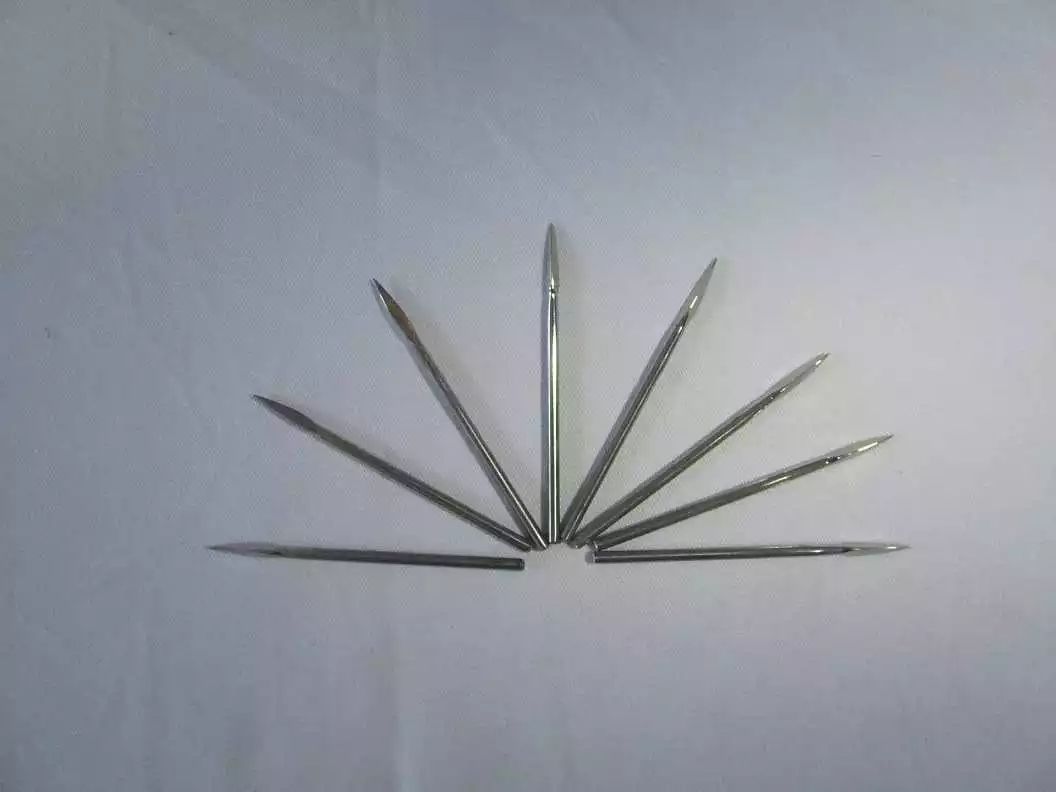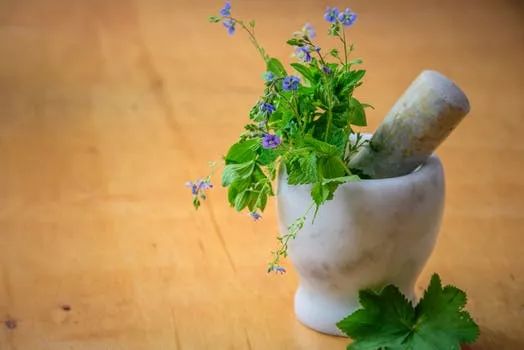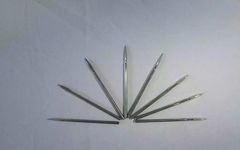“Bloodletting therapy” is also known as “pricking therapy.” It involves using a needle to prick acupuncture points, lesions, pathological reaction points, or superficial blood vessels to release a certain amount of blood for therapeutic purposes. The Sanleng needle originates from the ancient nine needles, specifically the “sharp needle.”
The Ling Shu: Nine Needles states that the sharp needle is primarily used for “draining heat through bloodletting.” The ancients placed great importance on bloodletting, as noted in the Suwen: Blood and Qi Formations, which states: “In treating diseases, one must first remove the blood.” The Ling Shu: Twelve Original Needles and Suwen: Great Discussion on Yin and Yang also propose the treatment principle of bloodletting: “If it is stagnant, it should be removed,” and “stagnant blood should be drained.” The Ling Shu: Official Needles describes methods such as “luo prick,” “zan prick,” and “leopard spot prick” for bloodletting. The Ling Shu: Blood Vessel Theory further clarifies the application scope of bloodletting therapy, stating that it is effective for conditions like “blood vessels being overly full and red,” and that it is only appropriate to “drain it completely” when there are obvious signs of blood stasis. This method has the effects of opening the orifices, draining heat, invigorating blood, and reducing swelling.

Operational Methods
(1) Needle Instruments
The Sanleng needle is mostly made of stainless steel, with a thicker cylindrical handle and a triangular needle body. The tip has three sharp edges, making it very sharp. There are large, medium, and small sizes, with medium and small being the most commonly used. Before use, the needle should be sterilized under high pressure or soaked in 70%-75% ethanol for 20-30 minutes.
(2) Needling Methods
Before needling, the local skin should be disinfected with a cotton ball containing 2% iodine, followed by deiodination with an alcohol cotton ball. The correct way to hold the needle is to pinch the handle with the thumb and index finger, controlling the direction of the needle, while the middle finger rests against the lower end of the needle body to control the depth of insertion. There are four needling methods as follows:
1. Point Pricking Method: Before needling, use the left thumb and index finger to press and squeeze the area above and below the intended needling site to accumulate blood at the site. After disinfection, use the left thumb, index finger, and middle finger to pinch or lift the acupuncture point, while the right hand holds the needle, exposing the tip by 1-2 fen (0.3-0.6 cm), aligning it with the acupuncture point and inserting it to a depth of 1-2 fen, then quickly withdrawing the needle. The left hand gently squeezes around the needle hole, and the right hand uses a disinfected cotton ball to wipe away the blood, allowing several drops to flow out. Finally, apply pressure to the needle hole with a disinfected cotton ball. This method is commonly used for points like Shixuan, Shierjing, Yintang, and Cuanzhu.
2. Scatter Pricking Method: This method involves pricking around the area of the lesion. Depending on the size of the lesion, more than 10-20 needles may be used, pricking in a circular pattern from the outer edge towards the center to promote the expulsion of blood stasis or edema, achieving the goal of “if it is stagnant, it should be removed” and promoting new blood flow. This method covers a larger area and is used for local blood stasis, hematomas, or edema, as well as stubborn skin conditions.
3. Bloodletting Method: First, use a rubber band to tie off the upper end (proximal end) of the needling site. After local disinfection, apply pressure with the left thumb on the lower end of the needling site, while the right hand holds the Sanleng needle and inserts it into the vein at the needling site, immediately withdrawing the needle to allow blood to drip out naturally. Release the rubber band, and once the desired amount of blood is obtained, apply pressure to the needle hole with a disinfected cotton ball. The depth of needling should be adjusted based on the depth of the vein and the amount of blood. This method is suitable for acupuncture points on the limbs, such as Weizhong and Chize. It can be performed once every 2-3 days, or once every 1-2 weeks for larger bloodletting. It is often used to treat acute vomiting, diarrhea, and heatstroke.
4. Tapping Method: Use the left hand to press on both sides of the treatment area or pinch the skin to stabilize it. The right hand quickly inserts the needle 1-2 mm into the skin, then tilts the needle to break the skin, allowing a small amount of blood or fluid to flow out. Alternatively, the needle can be inserted about 5 mm deep, tilting the needle and gently lifting the tip to break the underlying fibrous tissue, then withdrawing the needle and covering the area with a dressing. This method is commonly used for vascular headaches, shoulder periarthritis, insomnia, gastric pain, cervical syndrome, and bronchial asthma.
(3) Effects
1. Opening the Orifices and Reviving the Spirit: For conditions such as heat invading the heart, phlegm-fire disturbing the heart, phlegm obstructing the orifices, and severe anger damaging the liver, leading to symptoms like locked jaw, delirium, and constipation, bloodletting can effectively open the orifices and revive the spirit. Clinically, it is often used to treat coma, convulsions, mania, and heatstroke.
2. Draining Heat and Expelling Evil: The bloodletting method has a good effect of clearing heat and draining fire, especially suitable for external heat and various Yang excess fevers. Clinically, it is often used to treat certain acute infectious diseases.
3. Resolving Stasis and Unblocking Meridians: The bloodletting method can unblock the meridians, promote the flow of Qi and blood, and eliminate stagnation. It is suitable for symptoms caused by Qi and blood stagnation or local blood stasis. Clinically, it is used to treat vascular headaches, post-stroke sequelae, and various swellings and pains caused by injuries.
4. Regulating Qi and Nourishing the Nutrients: Bloodletting can harmonize the Ying and Wei, suitable for symptoms like dizziness, headaches, chest tightness, abdominal pain, diarrhea, and insomnia caused by Qi and blood counterflow or disorder of Ying and Wei.
5. Detoxification and Emergency Rescue: It has good detoxifying effects for acute carbon monoxide poisoning, alcohol poisoning, infectious poisoning, and insect or snake bites, allowing toxins to be expelled with the blood.
(4) Acupuncture Point Selection
1. Specific Points: Specific points correspond closely with the organs and meridians, having special effects, thus are commonly used for bloodletting. For example, during emergencies, Shixuan or Shierjing points are often pricked.
2. Extraordinary Points: Extraordinary points have significant effects on certain conditions, thus are commonly used for pricking. For instance, pricking Jinjun and Yuye for tongue swelling, or pricking Taiyang for eye redness and pain.
3. Other Pathological Reaction Points: For conditions like gastric pain, vomiting, lymphadenopathy, and eye diseases, small dark red spots can be found on the chest, abdomen, or back, which are reaction points of the organs on the body surface and can be pricked for bloodletting. For visible veins, points on the head, face, under the tongue, armpits, elbow pits, back of the ears, and ear tips can be used for bloodletting. Additionally, bloodletting can be performed at the sites of blood stasis, abscesses, and skin diseases.
(5) Amount of Bloodletting
The effectiveness of the Sanleng needle bloodletting therapy is closely related to the amount of blood drawn, which varies based on the patient’s constitution, the site of bloodletting, and the condition.
1. Minimal Amount: Less than 20 drops, including local congestion and oozing, mainly used for larger superficial conditions like neurodermatitis, stubborn skin diseases, and chronic ulcers of the lower limbs.
2. Small Amount: More than 20 drops, mainly used for acupuncture points on the head, face, and limbs (toes) and acute febrile diseases like acute conjunctivitis and acute tonsillitis.
3. Moderate Amount: Less than 15 ml, mainly used for surgical infectious diseases and some acute conditions like furuncles, carbuncles, and acute soft tissue injuries.
4. Large Amount: More than 15 ml, reaching dozens or even hundreds of milliliters, can be used for certain acute conditions like stroke and mania.
During treatment, if a large amount of blood is drawn, it can be spaced out by a week, a month, or even half a year; if a small amount is drawn, it can be done every 1-2 days.

Health Applications
1. Hypertension: Prick Taiyang and Yintang, drawing 1-2 ml each; Quxi and Weizhong, drawing 1-2 ml each; Dazhui and Ganshu, drawing about 2 ml each, plus cupping.
2. Headache: ① For unilateral headaches, prick the Taiyang point to release 2 ml of blood. ② For frontal headaches, prick both Taiyang and Yintang; for migraines, prick both Taiyang and Shuai Gu; for occipital headaches, prick Dazhui and Baihui. Bloodletting is often performed at visible veins around the selected points.
3. Fever: Prick Shixuan and Yujie, drawing 10-20 drops; Dazhui and Weizhong, drawing 2 ml.
4. Cold: Prick Fengmen, Feishu, and Shaoshang, each drawing 3-5 drops; if fever is present, prick the ear tip for 3-5 drops. Pricking both Zhongchong and Shaoshang can prevent influenza.
5. Stroke Closed Syndrome: Bloodletting 50-100 ml along the veins, ear veins, or temporal veins. For sequelae, prick Baihui, Shixuan, and Weizhong, drawing several drops from each point. For prevention, prick Zusanli, Quchi, and Dazhui, drawing several drops.
6. Cough: Prick Chize and Fenglong, drawing several drops; or prick Feishu and apply cupping. For chronic cough, the Yujie point may show visible veins, pricking for bloodletting; if phlegm is stagnant, Gongsun and Rangu may show purple veins, pricking for bloodletting and adding Fenglong and cupping.
7. Gastric Pain: Prick Zusanli to draw 3-5 drops, and apply cupping to Zhongwan and Liangqiu; prick Neiguan and Gongsun, drawing 0.5-1 ml each.
8. Epilepsy: Bloodletting 2-3 drops between each spinal process from Fengfu to Changqiang; prick Zhongwan, Juqie, Jiutai, and Shenting, drawing 2-3 drops from each.
9. Shoulder Periarthritis: Prick the three shoulder points and Ashi point, drawing about 3 ml, plus cupping.
10. Low Back Pain: Prick the visible veins at Weizhong, drawing about 3 ml. Prick Shenshu and Ashi, drawing about 1 ml, plus cupping.
11. Stiff Neck: Prick the affected side Tianzhu and Dazhu, each drawing 0.5 ml; prick Fengchi, Jianjing, and Ashi, each drawing 0.5 ml, plus cupping.
12. Erysipelas: Prick Xuehai, Diji, Yinbai, and Shaoshang, drawing several drops; at the lesion site and surrounding dilated small veins, prick and apply cupping, drawing several ml; along the “red line,” prick and draw several ml.
13. Hemorrhoids: Prick the Yinjiao point or small nodules on the frenulum, drawing 1-2 drops; prick Weizhong, Changqiang, and Dachangshu, drawing 5-10 drops.
14. Furuncles: Lightly prick around healthy skin near the furuncle to draw several drops; prick Dazhui and Chize at the distal or adjacent acupuncture points of the affected meridian, drawing several drops.
15. Breast Abscess: Prick Shanzhong and apply cupping; prick Shangyang, drawing 3-5 drops; prick Jianjing, pricking the visible veins around the affected breast, drawing 2-4 ml.
16. Soft Tissue Strains: Prick the area of local swelling and pain, and apply cupping as needed.
17. Stye: Prick Quchi, Taiyang, and Ganshu, drawing 5 drops; prick the ear tip for about 10 drops; search for reaction points in the scapular area on the back (if no reaction point is found, prick Gao Huangshu), drawing several drops.
18. Nicotine Addiction: Prick Liekui, Zhongchong, Shenmen, and Zusanli, each drawing 5-10 drops; prick the Tianmei point (midpoint between Yangxi and Liekui), drawing 5-10 drops; for ear points, prick Fei, Qiguang, Shenmen, Pingjian, and Nao, alternating between both ears.
Precautions
1. Provide adequate explanations to prevent patients from fainting due to fear of pain.
2. Strictly adhere to aseptic techniques to prevent infections, especially at ear points.
3. When using point or scatter pricking, the technique should be light, shallow, and quick; during bloodletting, aim directly at the vein with a single puncture. 4. Avoid using bloodletting on arterial blood vessels and larger veins. 5. Do not directly needle areas with skin infections, ulcers, scars, or unexplained lumps; needle surrounding points instead. 6. Bloodletting is contraindicated for patients with deficiency syndromes, women during menstruation, perinatal periods, significant external bleeding, or bleeding tendencies.
7. Before needling, consider the amount of blood to be drawn based on the condition; do not blindly draw blood.
Disclaimer: This article is sourced from the internet, and the copyright belongs to the original author. The content is for sharing, discussion, and learning reference only, and does not represent the views of the public account. Please think objectively, do not follow blindly, and do not reject. If there are copyright issues, please contact for removal.

